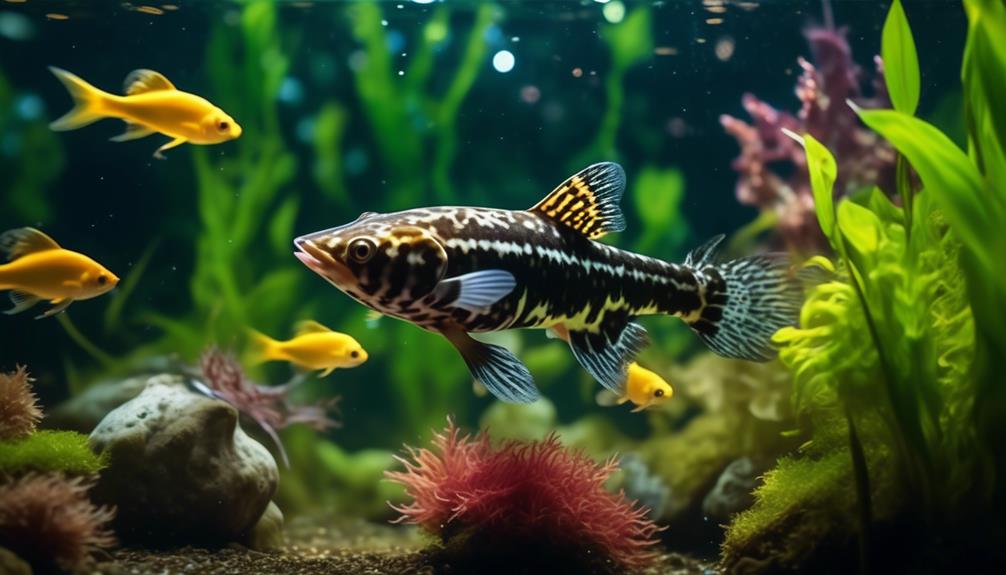Otocinclus catfish, commonly known as 'otos', have long captivated the attention of aquarium enthusiasts with their remarkable ability to efficiently devour algae.
These small South American catfish, ranging from 1.5 to 2 inches in size, possess a unique affinity for softer varieties of algae, while avoiding the harder types.
But what makes these otos so adept at algae consumption? And how can one create an ideal habitat for these algae-munching marvels?
In this article, we will unravel the secrets of otocinclus catfish, providing valuable insights into their eating habits, purchasing tips, optimal aquarium setup, and even their breeding techniques.
Prepare to be fascinated by the world of otos, as we delve into the intriguing world of these algae-munching marvels.
Key Takeaways
- Otocinclus catfish, commonly known as otos, are a genus of South American catfish known for their algae-eating habits.
- They specialize in consuming softer types of algae like soft green algae and brown diatoms, while avoiding harder types like black beard or green spot algae.
- Otos primarily rely on algae as their main source of food in the aquarium, but they also eat biofilm that grows on driftwood and other botanicals.
- When purchasing otos, it is important to set up a quarantine tank with plenty of algae for them to eat, choose healthy individuals with round abdomens, and offer different kinds of foods to see what they will eat.
Otocinclus Catfish Overview
The Otocinclus catfish, commonly referred to as otos, is a genus of South American catfish consisting of approximately 20 species. These small catfish are particularly sought after for their algae-eating capabilities, making them popular additions to community tanks.
The diversity of Oto species allows for a range of choices when selecting the perfect addition to a tank. From the well-known O. vittatus to the striking O. macrospilus and O. cocama, there is a variety to suit every aquarist's preferences.
Otos are primarily diurnal and can be found grazing or resting on various surfaces. Their ability to consume algae makes them excellent additions to community tanks, as they help to maintain the balance of the ecosystem by controlling algae growth.
Algae Eating Habits
Otos exhibit a strong affinity for consuming various forms of algae, displaying a particular preference for softer varieties such as soft green algae and brown diatoms. They are highly efficient algae eaters and play a crucial role in maintaining a healthy aquatic environment.
Algae control methods can be enhanced by introducing otos into the aquarium as they actively consume algae, preventing its overgrowth. By targeting softer algae types, otos effectively prevent the spread of unsightly green algae and diatoms, keeping the tank visually appealing. This natural algae control method is preferable to using chemical treatments, which can be harmful to other aquatic organisms.
To prevent the growth of unwanted algae, it is important to maintain a balanced aquarium environment with proper lighting, regular water changes, and appropriate nutrient levels.
Purchasing Tips

When purchasing otos, it is important to consider several factors to ensure their health and well-being in the aquarium. Here are some tips to keep in mind:
- Oto quarantine: Set up a separate quarantine tank before bringing otos home. This will allow you to observe their behavior and ensure they are free from any diseases or parasites before introducing them to the main tank.
- Provide plenty of algae: Make sure the quarantine tank has ample algae for the otos to eat. This will help them acclimate to their new environment and provide them with the necessary nutrition.
- Food preferences: Otos primarily eat algae, but they may also accept other types of food. Offer them a variety of foods, such as algae wafers or blanched vegetables, to see what they prefer. It is important to provide a balanced diet to meet their nutritional needs.
Aquarium Setup
To create an optimal environment for otos, careful consideration must be given to the setup of the aquarium.
Otocinclus catfish thrive in a mature aquarium with ample algae and biofilm. It is recommended to add slow-growing plants with flat leaves, as these attract algae, providing a natural food source for the otos.
Additionally, regularly scraping off algae from the front aquarium panel can provide more food for the otos. When choosing tankmates, it is important to select fish species that are compatible with the otos' peaceful nature and do not compete for the same food sources.
Maintaining water quality is crucial for the health and well-being of otos. Regular water changes and monitoring of parameters such as temperature, pH, and ammonia levels are essential.
Breeding Information

Breeding otos, also known as Otocinclus catfish, involves specific considerations and techniques to successfully replicate their natural spawning behaviors in a controlled aquarium environment. To ensure successful breeding, the following techniques and behaviors should be taken into account:
- Breeding Techniques:
- Condition the otos for spawning by providing them with a diet rich in protein. This will help promote healthy reproductive activity.
- Induce breeding by imitating the conditions of seasonal flooding and heavy rainfall. This can be achieved by performing regular water changes and adjusting the temperature and lighting in the tank.
- Spawning Behavior:
- Female otos are slightly larger and broader than males. Observing these physical differences can help identify potential breeding pairs.
- Once the female lays adhesive eggs, it is important to remove them from the tank to prevent them from being eaten by other fish or even the parents themselves.
Frequently Asked Questions
Can Otocinclus Catfish Live With Other Fish in a Community Tank?
Otocinclus catfish can live with other fish in a community tank. They provide benefits such as algae control and a unique addition to the tank's ecosystem. However, compatibility with other species should be considered to ensure a harmonious environment.
How Long Do Otocinclus Catfish Live?
Otocinclus catfish have an average lifespan of 3-5 years in optimal conditions. To ensure their longevity, provide a well-maintained aquarium with abundant algae and biofilm, and choose compatible tank mates such as small peaceful fish and shrimp.
Do Otocinclus Catfish Need a Heater in Their Tank?
Otocinclus catfish do not require a heater in their tank but thrive in temperatures between 70-79°F. A mature aquarium with plenty of algae and biofilm is essential for their well-being. It is important to avoid overstocking the tank to ensure enough food for all otos.
How Often Should Otocinclus Catfish Be Fed?
Otocinclus catfish should be fed small amounts of food multiple times a day to mimic their grazing behavior in the wild. Ideal tank conditions include plenty of algae and biofilm, a mature aquarium, and proper temperature and pH levels.
Are Otocinclus Catfish Prone to Any Specific Diseases or Health Issues?
Otocinclus catfish are generally hardy and resistant to diseases, but they can be susceptible to common health issues such as parasitic infections, bacterial infections, and poor water quality. Regular monitoring and maintenance of water parameters are essential for their overall well-being.
Conclusion
In conclusion, the Otocinclus catfish, also known as 'otos,' are fascinating creatures highly regarded for their efficient algae-eating habits. With a unique affinity for softer varieties of algae, they contribute to maintaining a healthy aquatic environment.
By following purchasing tips, setting up an optimal aquarium, and understanding breeding techniques, enthusiasts can create a thriving habitat for these algae-munching marvels.
Like diligent gardeners of the underwater world, otos diligently graze on algae, ensuring a beautiful and balanced ecosystem in their aquatic realm.

